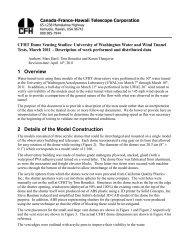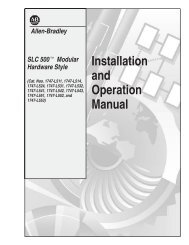Documentation [PDF] - Canada France Hawaii Telescope ...
Documentation [PDF] - Canada France Hawaii Telescope ...
Documentation [PDF] - Canada France Hawaii Telescope ...
You also want an ePaper? Increase the reach of your titles
YUMPU automatically turns print PDFs into web optimized ePapers that Google loves.
Field name Reference center Comment<br />
RA DEC<br />
(J2000) (J2000)<br />
D1 02:25:59.00 −04:29:40<br />
D2 10:00:28.00 +02:12:30 COSMOS u ∗ data included<br />
D3 14:19:27.00 +52:40:56<br />
D4 22:15:31.00 −17:43:56<br />
Table 17: Location of the CFHTLS Deep fields. All fields cover 1 deg 2 and are taken in all six filters.<br />
5 Description of the CFHTLS T0007 Deep survey<br />
5.1 Overview<br />
The CFHTLS Deep survey is composed of four independent MegaCam pointings in the D1, D2, D3 and<br />
D4 fields, whose sky location is shown in Figure 1, observed in all six MegaCam filters. It is composed of<br />
96 u ∗ , g, r, i, y and z stacks and 16 chi2 images (that is 112 images including the weight-maps). There are<br />
two types of stacks per Deep field: the “85%” best seeing images (hereafter the Dk-85 sample, k = 1 − 4)<br />
and the “25%” best seeing images (Dk-25). The two Dk series of stacks have exactly the same center<br />
positions.<br />
The image selection criteria applied to the 10632 CFHTLS images for the production of the CFHTLS<br />
Deep survey has already been described in Section 3.4. Note that in addition to the CFHTLS images<br />
taken between May 26, 2003 and February 02, 2009 on the D2-u∗ field contains MegaCam images taken<br />
by the COSMOS consortium (Capak et al., 2007).<br />
The T0007 CFHTLS Deep survey contains in total 8916 images. After proper selection, the remaining<br />
8638 images were combined into stacks as follows: 634 u ∗ , 1457 g, 1932 r, 1990 i, 691 y and 1934 z.<br />
All stacks have the same pixel scale and cover exactly 1×1 deg 2 (19354×19354 pixels of 0.1860"). For<br />
all fields with the exception of D2-u ∗ the stacks are only composed of images that are part of a CFHTLS<br />
Deep observing sequence and that are within a radius of 3 arc-minutes with respect to the CFHTLS Deep<br />
center fields. For the D2-u ∗ , we included all u ∗ -COSMOS images that passed the selection, without<br />
restriction on the radial distance.<br />
The Deep stacks combine sets of images obtained during sequences of medium exposures (few hundreds<br />
of seconds). Each exposure is followed by a small shift of the telescope to fill the physical gaps between<br />
CCDs. The shifts are within a box of 4 ′ in DEC and 3 arcminutes in RA. The D2-u ∗ stacks COSMOS<br />
data are shifted by 30 arcminutes in both RA and DEC directions in order to pave the 1.4×1.4 deg 2 of<br />
the COSMOS survey. These images are combined with CFHTLS D2-u ∗ observations and cut to provide the<br />
1×1 deg 2 centered on the CFHTLS D2.<br />
The center position of each stack is predefined. The coordinates of a stack center position are given<br />
in Table 17, and are exactly the same for all filters. D1, D2, D3 and D4 are therefore composed of a<br />
complete set of u ∗ , g, r, i, y and z images of 1 deg 2 each.<br />
Tables 18 and 19 summarize the properties of Deep median-combined stacks; the characteristics of the<br />
sigma-combined stacks are given in Tables20 and 21. (Note that the exposure time u ∗ -band does not<br />
69


![Documentation [PDF] - Canada France Hawaii Telescope ...](https://img.yumpu.com/26965302/81/500x640/documentation-pdf-canada-france-hawaii-telescope-.jpg)









